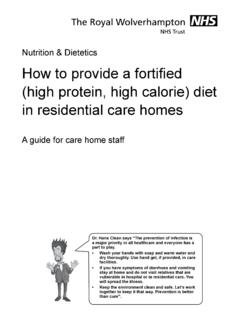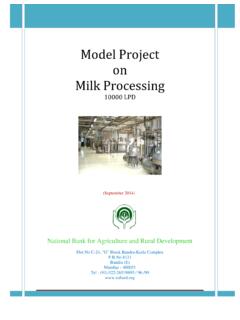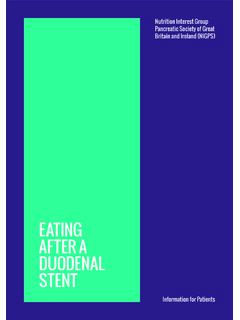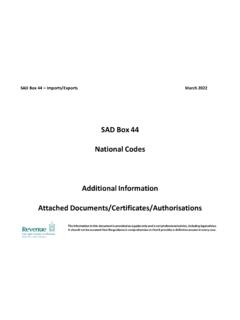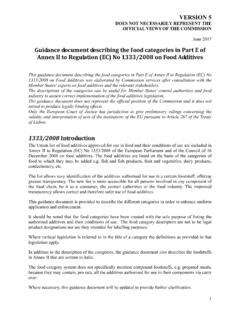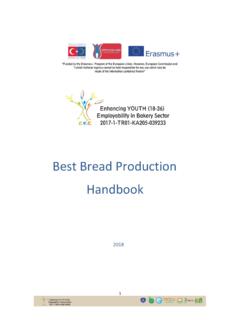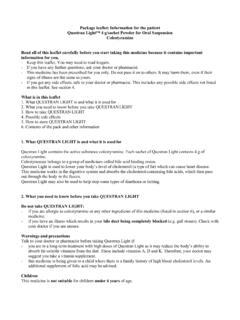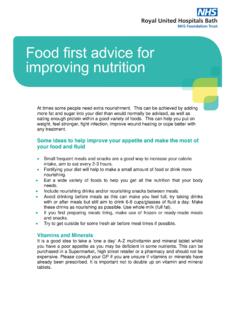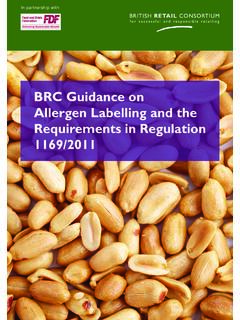Transcription of Milk Powder Production - Dairy Consultant
1 milk Powder Production milk Powder Production - milk Powder Producers - milk Powder Specification Some links for manufacturers of powders Calculator for milk fat % to give desired fat % in milk Powder milk Powder Production Cost estimation calculator Whole milk Powder Specification skimmed milk Powder Specification (Medium Heat) Whey Powder Specification milk Powder Dry Blending Factory Layout milk Spray Dryer Training milk Evaporator Training The photo below is of tubes and supports inside the evaporator calandria during construction. The tube wall material thickness and tube supports are critical the milk evaporator design. The straightness of the tubes is achieved by using evaporator Tube Supports and this is critical to good operation. A tube out of alignment or curved will result in an uneven flow of concentrate and will result in burning on, scorched particles, reduced running times and may lead to expensive blocked tubes and significant down time.
2 The steam side of the tubes. milk Powder Dry Blending plant layout options are cover further on the main Watson Dairy Consulting Website under Dairy Factory Design milk Powders Manufacturing - milk Powder Production process description The Spray Drying milk Powder Production process begins with liquid milk . (skim milk Powder , whole milk Powder , fat filled milk Powder , buttermilk Powder , whey Powder , cream Powder , cheese Powder , demineralised whey Powder , whey protein concentrate, infant formula milk Powder ) milk Powder Production Raw milk on arrival at the factory is rapid tested for acidity, smell, temperature, hygiene, antibiotics, water addition and adulteration and also for fat, protein and SNF. On acceptance the milk is pumped into a silo storage tank at the processing plant and held at temperatures below 7 C and usually below 5 C.
3 Raw whole milk has varying Fat & Solids Not Fat (SNF) content and typically between and Fat and 8% to 9% SNF giving typical Total Solids of Developing countries are milk solids usually lower and care should be taken in ensuring that costs / yields are calculated accurately for any planned high volume Dairy manufacturing plant and we suggest you prepare a very detailed yield spreadsheet., use the calculator on the link above to view the effect of protein or moisture variation on annual milk Powder Production yield and milk Powder profitability. milk is mostly collected in insulated tankers from Dairy farms or milk collection stations. Prior to collection the driver will carry out quality and measurement tests to ensure the milk is of the required quality. Adulteration of raw milk in some countries is prolific and a real barrier to globally operating companies establishing facilities due to the high brand risk involved.
4 When the raw milk arrives at the manufacturing plant it is usually separated into cream and skimmed milk to enable standardization of the fat content prior to spray drying. High volume manufacturers will automate this cream fat standardization using an inline standomat which doses cream back into the skim to give the correct fat % in the milk to be processed. Some high volume plants particularly in the US also standardise the SNF content to maximise yields and give a consistent quality. The microbial quality of milk powders is very important and it is possible at this early stage of processing to take out of the spore-forming bacteria by either bacto-fugation or microfiltration prior to heat treatment. This is a the ideal next stage but many processors primarily due to cost do not include this stage. Both processes require that the milk is first separated and then the skimmed milk portion has the bacteria removed and the cream is them high temperature pasteurised and returned to the milk (if required) This is the method used for ESL milk (Extended Shelf Life).
5 Infant Formula manufactures operating in developing countries should use a bactofuge or microfiltration plant to ensure finished produt quality. The milk is high temperature short-time pasteurized (HTST) by heating to at least C and holding at or above this temperature for at least 15 seconds, (An equivalent temperature / time combination can be used). (MAP - Mycobacterium avium subspecies paratuberculosis may be capable of surviving pasteurization.) Most high volume liquid milk plants now operate on a higher holding time of 25 seconds to 35 seconds as a precaution over the possible survival of MAP which can cause Crohn s disease in humans. The latest research (2019) indicates that the optimum time and temperature combination for liquid milk is for 26 seconds. Heat treatment affects the functional properties of skim milk Powder and the keeping quality of whole milk Powder , so the temperature and time combinations used by manufacturers can vary widely depending on the required properties required of the finished Powder .
6 In skimmed milk Powder , the extent of heat treatment (and holding time) can be measured by the whey protein nitrogen index (WPNI), which measures the amount of un-denatured whey protein. skimmed milk Powder processing differs from whole milk and buttermilk processing by the heat treatment given to skim milk before evaporation. The skimmed milk heat treatment temperature coupled with the holding time determines the heat classification of the Powder produced. For skim milk Powder classified as low-heat , the milk is low temperature pasteurized with little or no holding required, while heat treatment for a high-heat method requires heating milk to 85-88 C and holding at this temperature for 15 to 30 seconds. There is no requirement to homogenize skimmed milk for Powder Production because of its low fat content. High heat, heat stable powders are also produced by varying the evaporation conditions.
7 Homogenisation is not a mandatory step in whole milk or buttermilk processing, but is usually applied in order to stop the fat separating out after re-constitution, which is particularly important in Infant Formula milk . 1 milk Powder Production Two stage homogenization is usually used as single stage can result in fat globules coalescing into larger globules more readily. This is considered important for infant formula manufacturing. Two stage homogenising is preferable to ensure minimal re-coalescing of globules take place. Fat globules with damaged protective membranes reduce milk Powder solubility and increase the risk of oxidative rancidity. Homogenization helps convert free fat into fat globules and membranes are regenerated by protein adsorption on the globule surfaces. milk Powder heat treatment varies depending on the finished product specification.
8 Infant formula milk Powder treatment is higher than most other powders. The aim is to destroy all pathogenic and as many of the other microorganisms present and to inactivate enzymes, particularly lipase, which can cause fat lipolysis during storage resulting in "off odours". This also reduces the risk of oxidative changes during storage. There are special treatments available from certain evaporator manufacturers that can provide a very good reduction in thermoduric bacteria which tend to grow in evaporators and cause issues with Powder quality (High thermophile counts) Counts vary depending on the time of year and type of feed. (usually winter silage feed increases thermophillic spore counts in raw milk ) Other optional ingredients such as vegetable fats, vitamins and minerals are added to the milk prior to drying, ensuring appropriate heat treatment The milk is concentrated in a series of calandrias in an evaporator to around 40-60% total solids, prior to Spray Drying.
9 Most milk evaporators are today of the falling film type where a fine film of milk / concentrate is passed down the tubes wetting the surface whilst steam is on the other side of the tube and the vapours extracted from the centre by vacuum. Vapours are normally recompressed in a vapour re-compressor making evaporators very efficient. Water from evaporators can be recovered and re used.. Evaporation of the milk prior to drying is done for reasons of energy efficiency as it is far cheaper to evaporate the water than to spray dry it. The energy used in multi pass evaporators with steam vapour recompression is about 10 times less than spray drying. milk Powder Spray Dryer milk Powder SPRAY DRYING milk Powder Spray Dryers Spray drying milk Powder involves atomizing concentrated milk (or other liquids) into a hot air stream (180 220 C).
10 The atomizer may be either a pressure nozzle or a centrifugal disc. By controlling the size of the droplets, the air temperature, and the airflow, it is possible to evaporate almost all the moisture while exposing the solids to relatively low temperatures. Spray drying yields milk powders with excellent solubility, flavour and colour. This is the most common procedure for manufacturing milk powders. The spray drying process is typically a two-stage process that involves the spray dryer at the first stage with a static fluid bed integrated in the base of the drying chamber. The second stage is an external vibrating fluid bed. Product is moved through the two stage process quickly to prevent overheating of the Powder . Powder leaves the dryer and enters a system of cyclones that simultaneously cools it. Spray dryers can also have bag filters to reduce environmental emissions and also to increase yield and ensure that there are no Powder particles emitted to attract birds and rodents and also act as a medium for microbial growth which can then be carried back into the plant.


